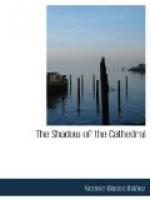The first storey of the facade was broken in the centre by the great Puerta del Perdon, an enormous and very deeply-recessed Gothic arch, which narrowed as it receded by the gradations of its mouldings, adorned by statues of apostles, under open-worked canopies, and by shields emblazoned with lions and castles. On the pillar dividing the doorway stood Jesus in kingly crown and mantle, thin and drawn out, with the look of emaciation and misery that the imagination of the Middle Ages conceived necessary for the expression of Divine sublimity. In the tympanum a relievo represented the Virgin surrounded by angels, robed in the habit of St. Ildefonso, a pious legend repeated in various parts of the building as though it were one of its chief glories.
On one side was the doorway called “de la Torre,"[1] on the other side that called “de los Escribanos,"[2] for by it entered in former days the guardians of public religion to take the oath to fulfil the duties of their office. Both were enriched with stone statues on the jambs, and by wreaths of little figures, foliage, and emblems that unrolled themselves among the mouldings till they met at the summit of the arch.
[Footnote 1: Of the Tower.]
[Footnote 2: Of the Scribes.]
Above these three doorways with their exuberant Gothic rose the second storey of Greco-Romano and almost modern construction, causing Gabriel the same annoyance as would a discordant trumpet interrupting a symphony. Jesus and the twelve apostles, all life size, seated at the table, each under his own canopied niche, could be seen above the central porch, shut in by the two tower-like buttresses which divided the front into three parts. Beyond, two rows of arcades of inferior design, belonging to the Italian palace, extended as far as those under which Gabriel had so often played as a child when living in the house of the bell-ringer.
The riches of the Church, thought Luna, were a misfortune for art; in a poorer church the uniformity of the ancient front would have been preserved. But, then, the Archbishop of Toledo had eleven millions of yearly revenue, and the Chapter as many more; they did not know what to do with their money, so started works and made reconstructions, and the decadent art produced monstrosities like that one of the Last Supper.
Above, again, rose the third storey, two great arches that lighted the large rose of the central nave. The whole was crowned by a balustrade of open-worked stone following the sinuosities of the frontage, between the two salient masses that guarded it, the tower and the Musarabe chapel.




